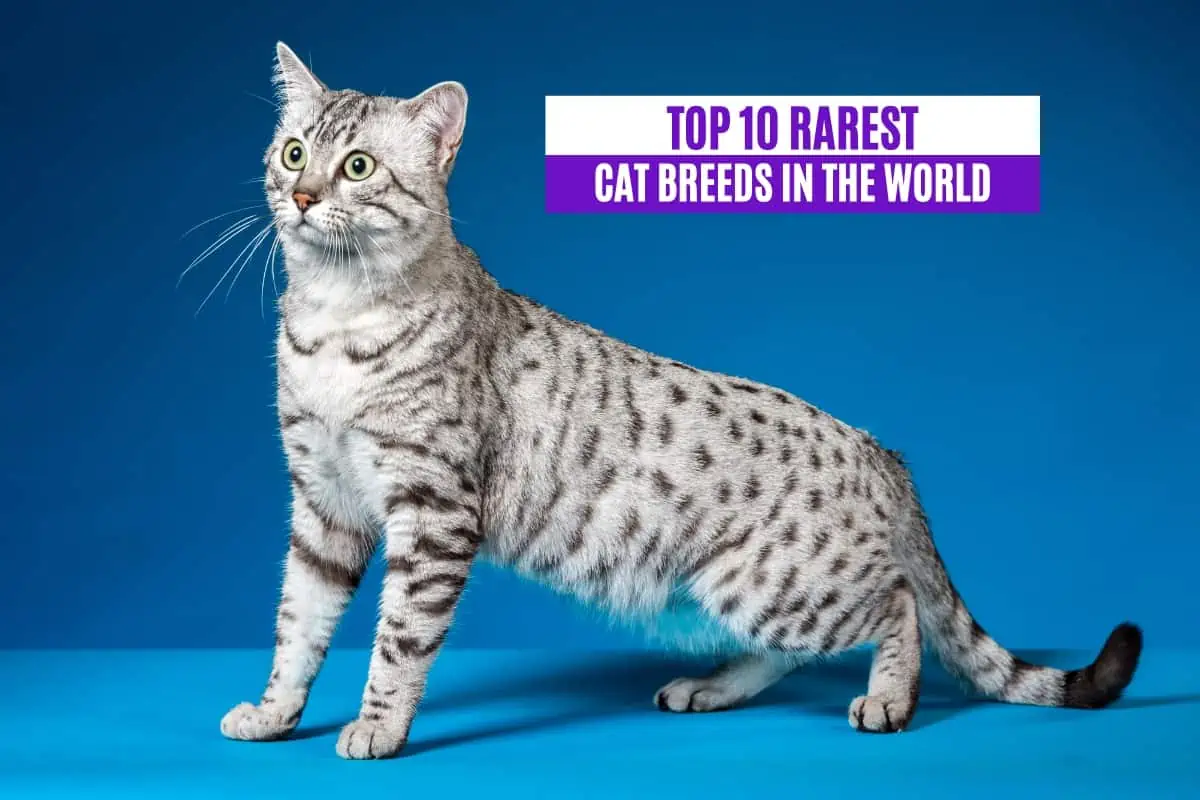People have been keeping cats as companions for thousands of years, with some of the earliest human-cat relationships dating back to 7500 BCE (about 9,500 years ago)! But as with dogs, cats have diversified quite a lot over the last several centuries, primarily due to human intervention and selective breeding techniques. This begs the question: Which cat breeds are the rarest?
The rarest cat breed is the Chantilly-Tiffany. It’s so rare, in fact, that it’s currently considered an extinct breed, with the last known Chantilly-Tiffany cat, Acey, born in 2013. Because she’s been spayed, the future of this breed looks dark, though some are attempting to revive the breed.
Although cats are some of the most popular house pets in the world, some breeds are far less common than others. This ranking will reveal which cat breeds are the rarest (and frequently most expensive)!
Here Are the Top 10 Rarest Cat Breeds in the World:
- Chantilly-Tiffany
- Savannah
- Turkish Van
- Sphynx
- Siberian
- American Wirehair
- Korat
- Devon Rex
- Egyptian Mau
- Turkish Angora
10. Turkish Angora
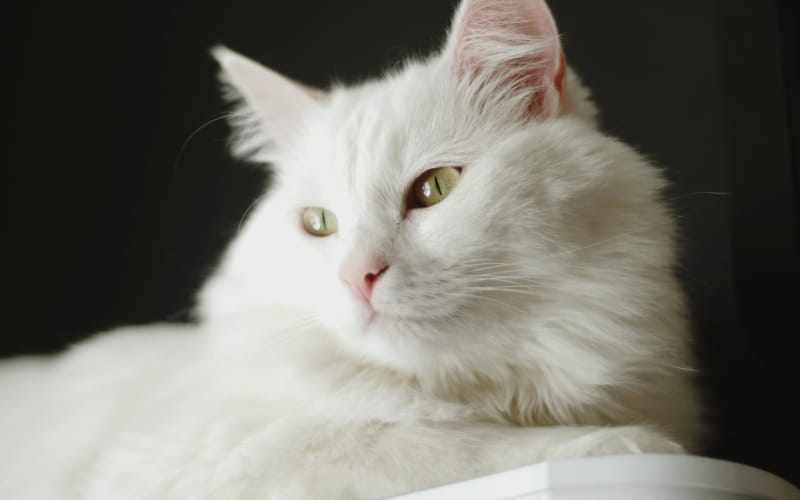
The Turkish Angora is traditionally a sleek, long-haired cat with silky-smooth snow-white fur and a penchant for playtime. This breed is also known for exhibiting an unusually high prevalence of heterochromia iridum, in which each eye presents a different color (much like Australian Shepherd dogs).
These highly intelligent and playful cats are often compared to dogs, as they can fetch, respond to specific commands, and enjoy several hours of daily activity and exercise.
But because all true Turkish Angora cats have lineages that trace back to Turkey, this breed is comparatively rare.
Why Is It So Rare?
Purebred cats must exhibit specific characteristics and have outstanding pedigrees (records of ancestry) proving Turkish descent. These strict requirements make the breed far rarer than standard domestic shorthair or longhair cats.
Still, the Turkish Angora isn’t the rarest Turkish cat breed! But we’ll touch on that in just a few moments.
9. Egyptian Mau
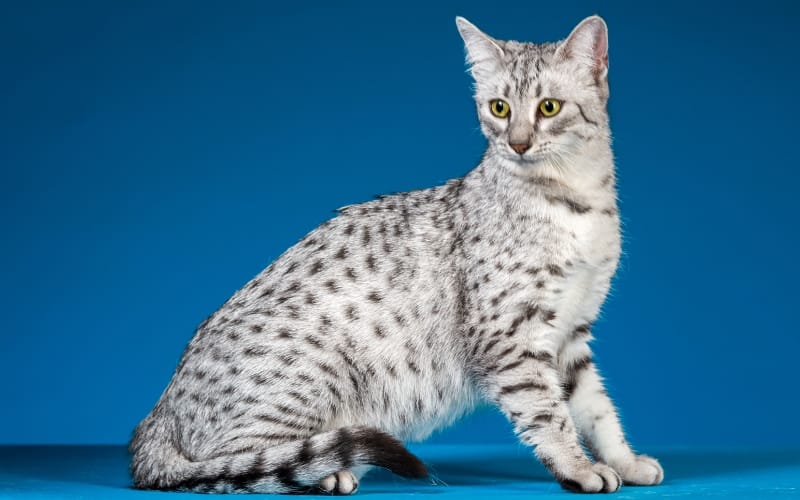
Some of the earliest depictions of cats created by humans are of the Egyptian Mau and its ancestors. Created by ancient Egyptians, many of these carvings and statues have withstood the test of time and now sit inside museums.
Funnily enough, the name of this breed translates to “Egyptian cat,” as “mau” is the Egyptian word for “cat.” Many have theorized that this word stems from the sound that cats make (meow)!
Recognizable thanks to its tabby-like markings and silver-blue coat, the Egyptian Mau is one of the most prized cat breeds in the world. They’re also incredibly expensive, with the average Egyptian Mau kitten costing more than $1,000.
You could own some of the rarest and most expensive Betta fish for that price. Of course, playing with your Egyptian Mau might be more exciting than watching your solitary Betta fish swim around all day.
But why are these felines considered some of the rarest cats on the planet?
Why Is It So Rare?
Although the Egyptian Mau breed dates back several thousand years, human activity has significantly threatened their livelihood over the last few centuries. World War II was one of the most notable incidents that significantly impacted the Egyptian Mau population.
During this war, many countries enforced rationing. This significantly decreased household food stores, making it almost impossible for pet owners to continue feeding their animals. Additionally, some people turned to eating their dogs and cats due to a lack of available meat.
A sudden drop in food, coupled with widespread devastation caused by fighting and artillery shelling, made the Egyptian Mau’s future uncertain. Fortunately, rapid breeding efforts in Europe and the United States helped keep the breed alive.
8. Devon Rex
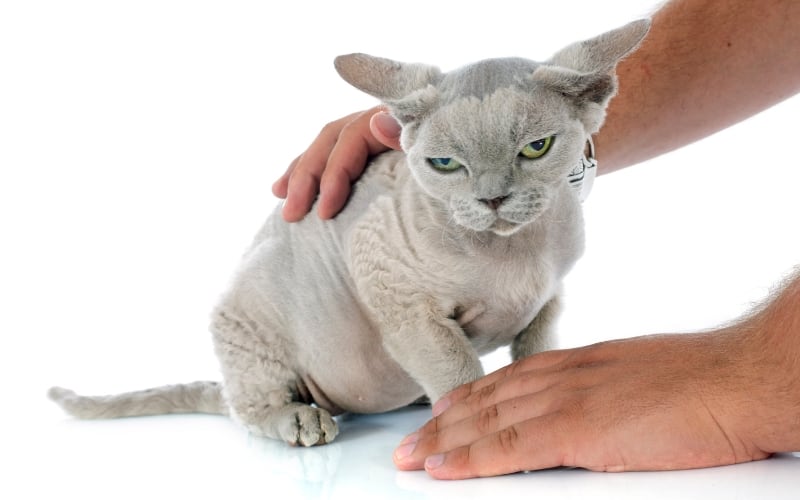
The average Devon Rex cat might have the resting facial expression of a grumpy old man, but the high-spirited personality of this cat breed belies its appearance. In fact, the Devon Rex might be the perfect cat for dog lovers due to its high-energy nature and exceptional intelligence.
But the Devon Rex might not be for you if you’re looking for a fluffy cuddle buddy. After all, these cats have exceptionally short hair and bat-like ears that make them some of the most easily recognizable felines in the world.
This appearance isn’t winning them any popularity contests, which is why the Devon Rex remains one of the rarest cat breeds.
Why Is It So Rare?
The distinct look of the Devon Rex is purely random, stemming from natural genetic mutations instead of concerted breeding efforts. So, while breeders have kept the Devon Rex breed alive, its creation was purely the result of genetic happenstance.
Still, the primary reason for this breed’s rarity might be its unusual appearance. When most people adopt a purebred cat or kitten, they look for a fluff ball with distinctly beautiful features.
It takes a special kind of person to fall in love with Devon Rex’s unconventional look! That said, their personalities often trump their unusual appearance, making them fantastic pets worthy of praise and unconditional love.
7. Korat
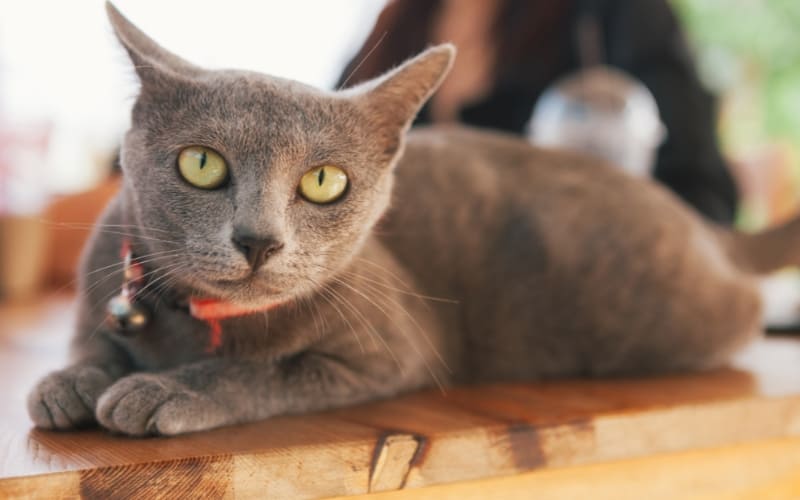
At first glance, it’s easy to confuse the Korat with a Russian Blue or an unmarked Egyptian Mau. After all, these cats have a silver-grey shorthair coat and jade-green eyes.
But unlike the previously-mentioned breeds, originating in Russia and Egypt, the Korat comes from Thailand. Additionally, these cats remain relatively small and thin throughout their lives, much like the hefty Russian Blue.
Sadly, unless you’re friends with one of the few American or European Korat cat breeders, there’s a good chance you’ll never get to meet one of these cats. Importation regulations make it almost impossible for breeders to purchase true Korat cats from Thailand, resulting in a below-average population.
Why Is It So Rare?
Few breeders specialize in producing Korat kittens. Consequently, this breed’s population remains limited, something that will likely continue due to strict animal importation/exportation policies.
6. American Wirehair
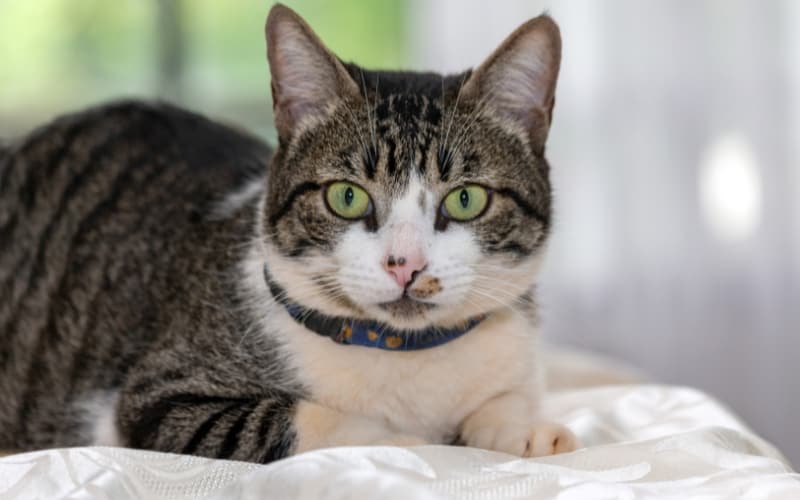
Random genetic mutations are responsible for producing some of the world’s rarest creatures and color patterns, including the rarest lobster colors! And the American Wirehair is an ideal example of how genetic variation and mutation can result in a one-of-a-kind animal.
As the name of this breed suggests, the American Wirehair has uniquely curly, coarse hair resembling small crimped wires. These coats are called “hard” due to their distinct, rough texture.
Why Is It So Rare?
Most pet owners look for an animal that’s pleasant to touch (or pet), and the American Wirehair doesn’t necessarily meet that need. Their wiry coats can be offputting for some.
That said, their laid-back demeanors can win the hearts of some cat lovers. Besides, the American Wirehair reproduces quite easily. So, in terms of rarity, it pretty much comes down to demand, which is unusually low for this breed.
5. Siberian
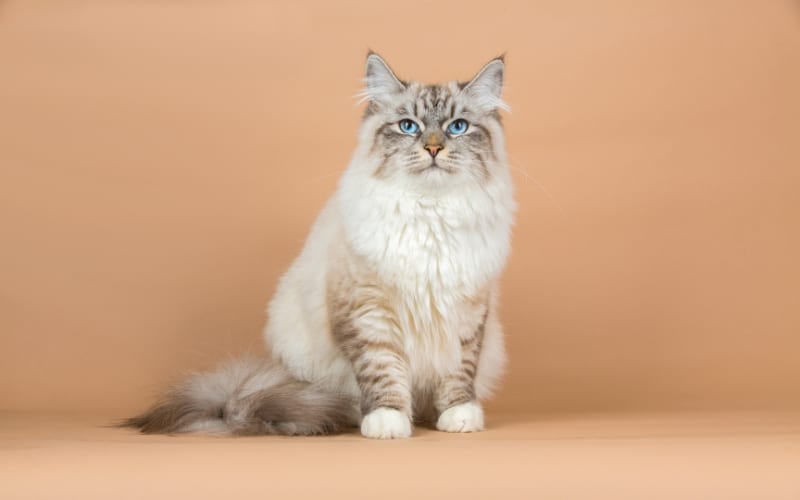
Do you love Maine Coon and Norwegian Forest cats? If so, you might want to turn your eyes to one of the rarest long-haired cats in the world, the Siberian.
One of the most iconic of all Russian felines, the Siberian is beloved for its thick, heavy coat and slightly squashed, boxy facial features. They’re also playful and intelligent, making them excellent companions for families of all types and sizes.
But finding a purebred Siberian, especially outside Europe and Russia, is challenging. If you live in the United States, you can expect to spend upwards of $1,000 for a Siberian kitten.
Why Is It So Rare?
The look and personality of Siberian cats make them a favorite for pet owners everywhere. But the population of native-born (aka born in Siberia) Siberian cats is quite low, so demand always outpaces supply.
As a result, these cats tend to be far rarer than their similar American counterparts, including the Maine Coon.
4. Sphynx
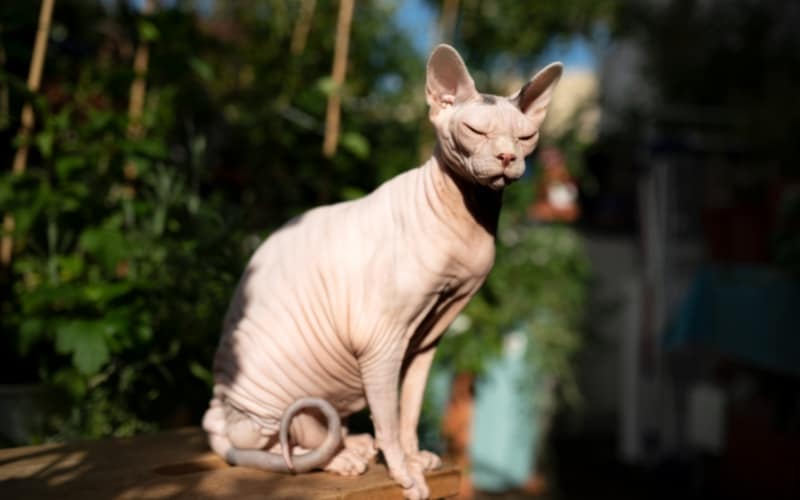
One of the major reasons why people avoid becoming cat owners is allergies.
When cats shed, which most do quite often, their hairs can collect along furnishings and flooring, filling the air with the Fel D1 protein. This protein comes from a cat’s saliva and can cause a wide range of allergic reactions, most often sneezing and congestion.
But if you adopt a cat like the Sphynx, you don’t need to really worry about allergies.
The result of a random genetic mutation (like many other rare cat breeds), the Sphynx is totally hairless. Some are also whisker-free, and most have webbed feet (kind of like ducks).
Although this breed’s wrinkled, bald appearance might not appeal to everyone, the Sphynx remains a beloved cat for those with allergies. Still, this hairless feline is so rare and beloved that the average Sphynx kitten costs about as much as some of the world’s most expensive birds!
Why Is It So Rare?
Believe it or not, the Sphynx is one of the most in-demand cats in the world.
Many batteries specializing in breeding Sphynx cats have multi-year waiting lists for kittens and cats. This demand makes the Sphynx unusually rare and incredibly expensive, with some Sphynx kittens costing up to $4,500.
3. Turkish Van

Remember when we mentioned that the Turkish Angora wasn’t the rarest cat from Turkey? Well, it’s time to introduce the Turkish Van!
While the Turkish Angora is a classically all-white feline, the Turkish Van comes in a variety of colors and color patterns, though most have significant patches of soft white fur. Still, in terms of coat length, both breeds exhibit medium-to-long hairs that vary in length across their bodies.
Like the Turkish Angora breed, the Turkish Van is notable for its strength, intelligence, and loyalty. These qualities make them top-notch companion cats.
But with only about 100 Turkish Van kittens being born in the United States each year, they’re far rarer than the Turkish Angora.
Why Is It So Rare?
Pretty much all Turking Van cats living outside of Turkey are descended from two cats brought to the United Kingdom in the 1950s. That fact alone should tell you how rare this breed is.
Additionally, these cats don’t reach full maturity until they’re about four years old. Most house cats reach sexual maturity when they’re only six months old! So producing Turkish Van kittens is far more time-consuming than creating kittens of other breeds, keeping the breed rare.
2. Savannah
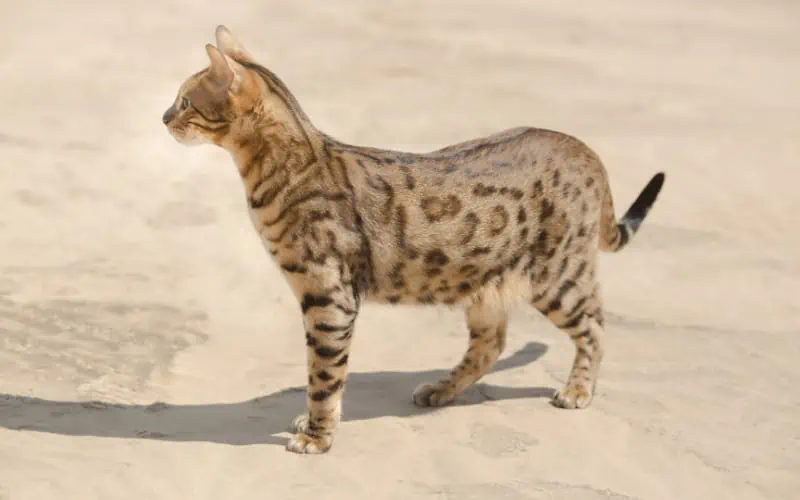
If you’re fond of large cats, you’ll probably fall in love with the Savannah cat. These cats are a mix of wild African serval cats and domestic cats (or hybrid serval-domestic offspring).
These massive spotted felines can grow up to 17 inches (about 43.2 centimeters) tall and several feet long, depending on their lineage. For example, F1 kittens (born from a pure serval cat and a mixed-breed serval) tend to grow to the largest sizes and exhibit the most recognizable traits of their wild ancestors and parents.
This breed is one of the priciest, with F1 Savannah cats can sell for up to $20,000 or more. But the high price-per-kitten isn’t the only reason why the Savannah cat breed is considered rare.
Why Is It So Rare?
There are many reasons why the Savannah cat is one of the rarest breeds. Some of the top reasons include:
- Breeding difficulties
- Male sterility
- Illegality throughout multiples states and countries
- Longer-than-average pregnancies
Savannah cats are hybrids, and they’re much larger than the average house cat. Like several of the world’s rarest dog breeds, getting two physically diverse felines to mate and produce offspring presents many challenges.
In fact, many of the reasons French Bulldogs are expensive is because they’re difficult to breed!
High percentage Savannahs, like the F1 generation Savannahs, are very difficult to breed. It takes many years and a lot of luck to mate a Serval with a domestic cat.
Instead, most are born from pre-existing serval-domestic hybrids. As you might imagine, these hybrids aren’t exactly numerous, making future Savannah cat generations comparatively rare.
1. Chantilly-Tiffany
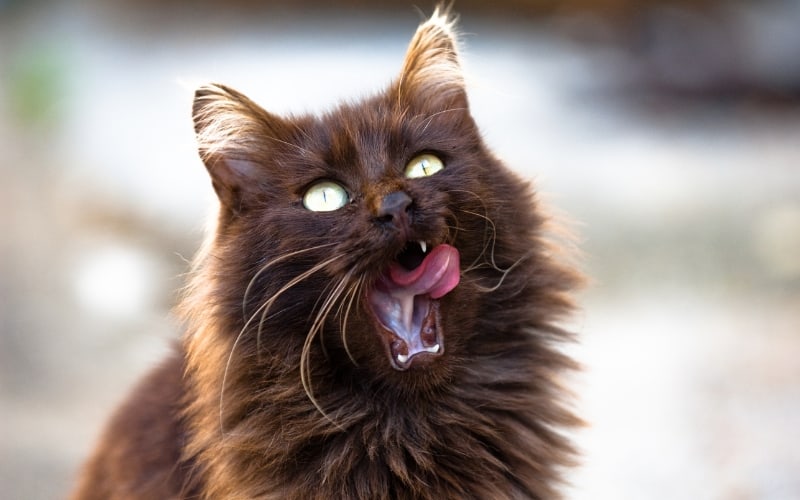
The rarest cat breed in the world is the Chantilly-Tiffany. This breed originated in the late 1960s in New York, but it’s virtually extinct today due to a lack of traceable lineages and pedigrees, as well as the last known Chantilly-Tiffany cattery (Amorino Cattery) burning down in 2012.
The last “true” Chantilly-Tiffany male was a chocolate-brown cat named Frosty. He passed away in 2015, leaving only a single descendant, a female named Acey. But this Chantilly-Tiffany was spayed after Frosty’s death, as there were no longer any “verifiable” Chantilly-Tiffany cats left for Acey to mate with.
Still, many cats exhibit the common traits and characteristics of this long-haired, golden-eyed cat breed. Although the original lineage is now lost, concerted breeding efforts could partially “resurrect” the Chantilly-Tiffany breed.
Why Is It So Rare?
A drastic drop in breeding endeavors, coupled with a catastrophic cattery fire, has made the Chantilly-Tiffany the rarest car breed in the world.
Few cat breeders have taken on the task of producing the iconic brown-furred Chantilly-Tiffany cat. Consequently, their numbers have always been quite small, especially compared to popular purebred cats like British Shorthair or Maine Coon.
By 2010, only one breeder was actively working to keep the Chantilly-Tiffany breed alive: Anne Davenport-Parini of the Amorino Cattery in Illinois. Tragically, Davenport-Parini’s cattery burned down in 2012 due to an electrical fire, leaving only a handful of purebred Chantilly-Tiffany cats unscathed.
Still, efforts are being made to revive this breed. The Chantilly/Tiffany Cat Project is one of the most significant teams looking to help the Chantilly-Tiffany cat become a registered purebred breed once again.
What’s the Rarest Cat Breed in the World?
The rarest cat breeds are the Chantilly-Tiffany (practically extinct), the Savannah cat, and the Turkish Van. Breeding difficulties, sudden disasters, and exportation/importation limits are some of the most common culprits when it comes to breed rarity.
The Chantilly-Tiffany breed is virtually gone, with only one known example of the breed (a female cat named Acey) surviving today. So, if you’re looking to own a rare feline, your best bet is to contact a reputable breeder specializing in producing Savannah cats.
Discover more about the world’s most expensive and rare animals. Check out these related articles now!

